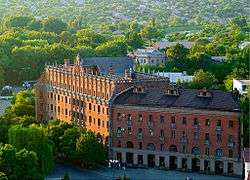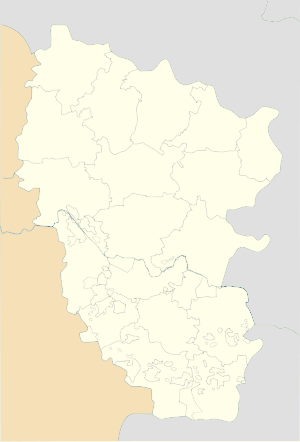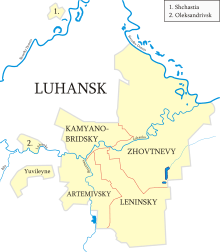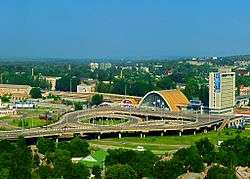Luhansk
Luhansk or Lugansk (UK: /luːˈhænsk/, US: /-ˈhɑːn-/; Ukrainian: Луганськ, romanized: Luhans'k, IPA: [lʊˈɦɑnʲsʲk] (![]()
Luhansk Луганськ Russian: Луганск | |
|---|---|
 Hotel Ukraine, architect Joseph Karakis | |
 Flag  Coat of arms | |
 Luhansk Location of Luhansk  Luhansk Luhansk (Ukraine) | |
| Coordinates: 48°34′0″N 39°20′0″E | |
| Country (de jure) | |
| Country (de facto) | |
| Oblast | Luhansk Oblast |
| Raion | City of Luhansk |
| Founded | 1795 |
| Area | |
| • Total | 257 km2 (99 sq mi) |
| Elevation | 105 m (344 ft) |
| Population (2013) | |
| • Total | 425,848 |
| • Density | 1,802/km2 (4,670/sq mi) |
| Postal code | 91000 |
| Area code(s) | +380 642 |
| Climate | Dfa |
| Website | http://gorod-lugansk.com |

History
The city traces its history to 1795 when the British industrialist Charles Gascoigne founded a metal factory near the Zaporizhian Cossacks settlement Kamianyi Brid. The settlement around the factory was known as Luganskiy Zavod. In 1882 the factory settlement Luganskiy Zavod was merged with the town of Kamianyi Brid into the city of Luhansk. Located in the Donets Basin, Luhansk developed into an important industrial center of Eastern Europe, particularly as a home to the major locomotive-building company Luhanskteplovoz. The city was occupied by Nazi Germany between 14 July 1942 and 14 February 1943.
On 5 November 1935, the city was renamed Voroshilovgrad (Russian: Ворошиловград, romanized: Voroshilovgrad; Ukrainian: Ворошиловград, romanized: Voroshylovhrad) in honour of Soviet military commander and politician Kliment Voroshilov. On 5 March 1958, with the call of Khrushchev not to give names of living people to cities, the old name was reinstated.[1][2] On 5 January 1970, after the death of Voroshilov on 2 December 1969, the name changed again to Voroshilovgrad. Finally, on 4 May 1990, a decree of the Supreme Soviet of the Ukrainian SSR gave the city back its original name.
In 1994 a referendum took place in the Donetsk Oblast and the Luhansk Oblast, with around 90% supporting the Russian language gaining status of an official language alongside Ukrainian, and for the Russian language to be an official language on a regional level; however, the referendum was annulled by the Ukrainian government.[3]
During the War in Donbass, separatists seized governmental buildings in the region, proclaiming the Luhansk People's Republic. An independence referendum, unconstitutional under the Ukrainian law, was held on 11 May 2014. This referendum was not recognized as legitimate by any government except South Ossetia.[4] Ukraine does not recognize the referendum, while the EU and US said the referendums were illegal.[5] The Republic of South Ossetia, a state with very limited international recognition, considered the referendum legitimate and recognized its outcome.[6][7]
On 25 June 2014, Luhansk was officially pronounced as the capital of the Luhansk People's Republic by the government of the separatist republic.[8]
In August 2014, Ukrainian government forces completely surrounded rebel-held Luhansk.[9] Heavy shelling caused civilian casualties in the city.[10][11][12] On 17 August, Ukrainian soldiers entered the rebel-controlled Luhansk and for a time had control over a police station.[13]
After the Ilovaisk counteroffensive, LPR forces regained Lutuhyne and other Luhansk suburbs. Ukrainian forces withdrew from the Luhansk International Airport on 1 September after heavy fighting.[14]
Luhansk became the capital and the administrative center of the rebel state of Luhansk People's Republic. The administration of the Luhansk Oblast was moved to Sievierodonetsk by the government of Ukraine.
Higher education

Some of the more prestigious universities in Ukraine have their home in Luhansk. Luhansk is the location of the main campus of the Taras Shevchenko National University of Luhansk, East Ukrainian Volodymyr Dahl National University and of Luhansk State Medical University.
Demographics
In the Ukrainian Census of 2001,[15] 49.6% of the inhabitants declared themselves as ethnically Ukrainians and 47% declared themselves as ethnically Russian. The most widespread native language was Russian, at 85.3% of the population. Ukrainian was the native language for 13.7% of the population, and there was also smaller numbers of speakers of Armenian (0.2%) and Belarusian (0.1%).
Sport
Lugansk is home to Zorya Luhansk which now plays in the Ukrainian Premier League annual football championship and plays at the Avanhard Stadium. The club won the 1972 Soviet Top League.
The other football team was Dynamo Luhansk.
Merheleva Ridge
On 7 September 2006, archaeologists in Ukraine announced that an ancient structure had been discovered near Luhansk, which the press reported as a pyramid antedating those in Egypt by at least 300 years. The stone foundations of the structure were said to resemble Aztec and Mayan pyramids in Mesoamerica. It was later concluded that the site in question was not a pyramid but was still of great interest.
Gallery
During 2014 and 2015, Luhansk has been the scene of intense fighting and most of these buildings are damaged to some extent. Some may be destroyed.
 Luhansk drama theatre
Luhansk drama theatre Luhansk University
Luhansk University Night Luhansk, Radianska street
Night Luhansk, Radianska street "Luhansk" hotel
"Luhansk" hotel St. Volodymyr Cathedral in Luhansk
St. Volodymyr Cathedral in Luhansk City history museum
City history museum Luhansk Railway station
Luhansk Railway station Soviet buildings in central Luhansk
Soviet buildings in central Luhansk City old hospital
City old hospital Vladimir Dal monument
Vladimir Dal monument Lugansk drama theatre
Lugansk drama theatre A consumer electronics and appliance store in Luhansk, heavily damaged as a consequence of the War in Donbass.
A consumer electronics and appliance store in Luhansk, heavily damaged as a consequence of the War in Donbass.
Notable people

- Nikolay Shmatko (born 1943), sculptor, professor and painter.
- Sergey Bubka (born 1963), Soviet and Ukrainian pole vaulter, former World Record holder, and Olympic Champion
- Vasiliy Bubka (born 1960), Soviet and Ukrainian pole vaulter
- Vladimir Dal (1801–1872), Russian lexicographer
- Fedor Emelianenko (born 1976), a mixed martial arts champion
- Andriy Serdinov (born 1982), Ukrainian swimmer
- Kliment Voroshilov (1881–1969), Soviet military commander
- Mikhail Matusovsky (1915–1990), Soviet poet, songwriter
- Oleksandr Zavarov (born 1961), Soviet and Ukrainian football player and coach
- Valeriy Brumel (1942–2003), Soviet olympic champion
- Sergei Semak, Russian football player
- Viktor Onopko, Russian football player
- Yelyzaveta Bryzhina (Born 1989), Sprinter, Bronze Medal 4 × 100 m Relay London 2012
- T-DJ Milana (Julia Igorevna Rysina; born 1989), Ukrainian DJ, composer, dancer and model
- Tetyana Tereshchuk-Antipova (born 1969), 400m hurdler
Climate
Luhansk features hot summer humid continental climate (Dfa), it has both the highest and lowest temperature recorded in Ukraine; a record high of 42.0 °C (107.6 °F) was recorded on 12 August 2010 while a record low of −41.9 °C (−43.4 °F) was recorded on 8 January 1935.[16]
| Climate data for Luhansk | |||||||||||||
|---|---|---|---|---|---|---|---|---|---|---|---|---|---|
| Month | Jan | Feb | Mar | Apr | May | Jun | Jul | Aug | Sep | Oct | Nov | Dec | Year |
| Record high °C (°F) | 12.8 (55.0) |
17.3 (63.1) |
23.1 (73.6) |
31.8 (89.2) |
36.6 (97.9) |
39.4 (102.9) |
40.5 (104.9) |
42.0 (107.6) |
36.8 (98.2) |
31.2 (88.2) |
22.8 (73.0) |
15.6 (60.1) |
42.0 (107.6) |
| Average high °C (°F) | −1.0 (30.2) |
−0.4 (31.3) |
5.7 (42.3) |
15.6 (60.1) |
22.2 (72.0) |
26.4 (79.5) |
28.7 (83.7) |
28.2 (82.8) |
21.8 (71.2) |
13.9 (57.0) |
5.2 (41.4) |
0.1 (32.2) |
13.9 (57.0) |
| Daily mean °C (°F) | −4.0 (24.8) |
−4.1 (24.6) |
1.4 (34.5) |
9.7 (49.5) |
15.8 (60.4) |
20.1 (68.2) |
22.3 (72.1) |
21.2 (70.2) |
15.3 (59.5) |
8.6 (47.5) |
1.8 (35.2) |
−2.7 (27.1) |
8.8 (47.8) |
| Average low °C (°F) | −6.8 (19.8) |
−7.4 (18.7) |
−2.4 (27.7) |
4.2 (39.6) |
9.4 (48.9) |
13.8 (56.8) |
16.0 (60.8) |
14.5 (58.1) |
9.4 (48.9) |
4.0 (39.2) |
−1.3 (29.7) |
−5.5 (22.1) |
4.0 (39.2) |
| Record low °C (°F) | −41.9 (−43.4) |
−36.9 (−34.4) |
−27.3 (−17.1) |
−12.1 (10.2) |
−8.2 (17.2) |
−1.8 (28.8) |
5.2 (41.4) |
−0.4 (31.3) |
−7.2 (19.0) |
−16.3 (2.7) |
−26.3 (−15.3) |
−29.6 (−21.3) |
−41.9 (−43.4) |
| Average precipitation mm (inches) | 36 (1.4) |
36 (1.4) |
32 (1.3) |
33 (1.3) |
50 (2.0) |
61 (2.4) |
63 (2.5) |
34 (1.3) |
45 (1.8) |
35 (1.4) |
39 (1.5) |
39 (1.5) |
503 (19.8) |
| Average rainy days | 10 | 8 | 11 | 14 | 13 | 14 | 12 | 8 | 11 | 11 | 13 | 10 | 135 |
| Average snowy days | 17 | 16 | 10 | 1 | 0.1 | 0.03 | 0 | 0 | 0.1 | 1 | 7 | 16 | 68 |
| Average relative humidity (%) | 84 | 82 | 77 | 65 | 62 | 63 | 63 | 60 | 67 | 75 | 84 | 85 | 72 |
| Source: Pogoda.ru.net[17] | |||||||||||||
International relations
Luhansk is twinned with:
- Cardiff, Wales[18][19]
- Lublin, Poland[19][20]
- Székesfehérvár, Hungary[19][21]
- Daqing, China[19][22]
- Saint-Étienne, France[19][23]
- Pernik, Bulgaria[19]
See also
- Luhansk People's Republic
- East Ukraine Volodymyr Dahl National University
- Luhansk Airlines
- Luhansk Airport
- Luhansk State Medical University
- Luhanskteplovoz
- University of Luhansk
- Merheleva Ridge
- Aviation Technical Museum (Luhansk)
References
- 'Военная Литература' – Биографии – С.Н. Хрущёв ['Military Literature' – Biographies – S. N. Khrushchev] (in Russian). Militera.lib.ru. Retrieved 30 October 2017.
- "Записки из Якирова Посада – Луганск-Ворошиловград-Луганск". Shusek.livejournal.com. 2 November 2009. Retrieved 16 September 2011.
- Донбасс: забытый референдум-1994 [Donbass: the forgotten referendum-1994] (in Russian). Thekievtimes.ua. 14 May 2014. Retrieved 30 October 2017.
- "Ukraine's Eastern Region Of Luhansk May Now Hold Referendum On Joining Russia". Business Insider. Retrieved 12 May 2014.
- "Ukraine rebels seek to join Russia". 12 May 2014. Retrieved 15 April 2019.
- The Earthtimes. "Nicaragua joins Russia in recognizing South Ossetia, Abkhazia, 3 September 2008". Earthtimes.org. Archived from the original on 7 July 2012. Retrieved 22 June 2010.
- "South Ossetia recognises independence of Donetsk People's Republic". Information Telegraph Agency of Russia. 27 June 2014. Retrieved 28 June 2014.
- ЗАКОН 'О системе исполнительных органов государственной власти Луганской Народной Республики' [LAW 'On the system of executive bodies of state power of the Lugansk People's Republic'] (in Russian). lugansk-online.info. 2014. Archived from the original on 15 September 2014. Retrieved 23 November 2014.
- "East Ukraine city of Luhansk dying under siege, residents say". The Denver Post. 5 August 2014.
- "Ukraine conflict: Under siege in Luhansk". Bbc.com. 13 August 2014. Retrieved 30 October 2017.
- "In Shell-Torn Luhansk, Food and Water Is Scarce: 'Welcome to Hell!'". Newsweek. 15 August 2014.
- Magnay, Diana; Lister, Tim (3 June 2014). "Air attack on pro-Russian separatists in Luhansk kills 8, stuns city". CNN. Retrieved 30 October 2017.
- "Ukraine troops claim breakthrough in battle for rebel city Luhansk". The Guardian. Reuters. 17 August 2014. Retrieved 17 August 2014.
- "Ukraine crisis: Troops abandon Luhansk airport after clashes". Bbc.com. 1 September 2014. Retrieved 30 October 2017.
- "All-Ukrainian Population Census '2001". State Statistics Committee of Ukraine.
- "Кліматичні рекорди" (in Ukrainian). Central Observatory for Geophysics. Archived from the original on 4 August 2016. Retrieved 4 August 2016.
- Погода и климат [Weather and climate] (in Russian). pogodaiklimat.ru. Archived from the original on 12 July 2014. Retrieved 30 November 2015.
- "Cardiff's twin cities". Cardiff Council. 15 June 2010. Archived from the original on 9 June 2011. Retrieved 10 August 2010.
- "History of Luhansk". Official site of Luhansk City Council. 15 October 2012. Retrieved 10 June 2015.
- "Miasta Partnerskie Lublina" [Partner Cities of Lublin]. Lublin.eu (in Polish). Lublin. Archived from the original on 16 January 2013. Retrieved 7 August 2013.
- "Partnervárosok Névsora Partner és Testvérvárosok Névsora" [Partner and Twin Cities List]. City of Székesfehérvár (in Hungarian). Archived from the original on 8 December 2012. Retrieved 5 August 2013.
- "大庆市与乌克兰卢甘斯克市的往来纪实". 大庆市外事侨务网站. Archived from the original on 11 May 2015. Retrieved 14 July 2014.
- Sue Bridger; Frances Pine (11 January 2013). Surviving Post-Socialism: Local Strategies and Regional Responses in Eastern Europe and the Former Soviet Union. Routledge. p. 190. ISBN 978-1-135-10715-4. Retrieved 9 June 2015.
External links
| Look up luhansk in Wiktionary, the free dictionary. |


- Official website of the Luhansk city council
- Former website of the Luhansk city council (last updated July 2015)
- Topographic map 1:100 000
- Historic images of Luhansk
- The sightseeings of Luhansk
